Business in Madagascar. Malagasy Economy

Madagascar (Foreign Trade): 50% of World's vanilla market. Antananarivo. Port of Toamasina
- Introduction to the Republic of Madagascar (East Africa)
- Malagasy Economy
- International Trade of Madagascar
- Economic partnership agreement with the EU
- Investment in Madagascar
- Business Opportunities in Madagascar
- Tourism
- Agribusiness
- Mining
- Light Industries
- Information and communications technology (ICT)
- Infrastructure
- Case Study:
- Socota Group (Textiles and Apparel)
- Madagascar Petroleum
- Economic Development Board of Madagascar
- Access to the Malagasy market
- Business Plan for Madagascar
The purposes of the subject “Foreign Trade and Business in Madagascar” are the following:
- To analyze the Malagasy Economy and Foreign Trade
- To know the trade opportunities in Madagascar
- To explore the Malagasy trade relations with the country of the student
- To know the Malagasy Trade Agreements
- To examine the profile of Malagasy companies
- To develop a business plan for the Malagasy market

The Subject “Foreign Trade and Business in Madagascar” belongs to the following Online Programs taught by EENI Global Business School:
Doctorate in African Business, World Trade.
Master in Business in Africa, International Business, Foreign Trade.


Languages:  or
or  Madagascar
Madagascar  Madagascar
Madagascar  Madagascar.
Madagascar.
- Credits of the subject “Doing Business in Madagascar”: 1

- Duration: one week
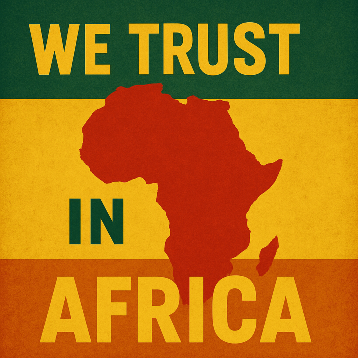
International Trade and Business in Madagascar
Madagascar: 50% of the World's vanilla market.
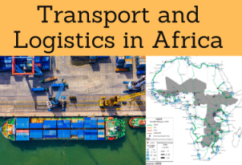


Malagasy Preferential Access and Trade Agreements:
- Madagascar and the East African Economic Area
- Common Market for Eastern and Southern Africa (COMESA)
- Southern African Development Community (SADC)
- EU-SADC Agreement
- COMESA-EAC-SADC Agreement
- African Continental Free-Trade Area
- Indian-Ocean Rim Association
- Indian Ocean Commission
- Arab Bank for Africa (BADEA)
- The U.S.-Madagascar
- EU-Madagascar
- Free Trade Agreement EU-Eastern and Southern African States (Madagascar, Mauritius, Seychelles, Zimbabwe)
- Africa-EU Partnership
- GSP
- Global System of Trade Preferences among Developing Countries (GSTP) - accession process
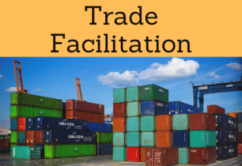
- WTO
- GATS
- Agreement on Sanitary Measures
- Agreement on Technical Barriers to Trade
- Agreement on Preshipment Inspection
- Agreement on Safeguards
- Trade Facilitation Agreement
- WCO
- BIC
- Chicago Convention (ICAO)
- IMO
- Convention for Safe Containers
- Istanbul Convention
- Rotterdam Rules (Sea)
- Hamburg Rules (Sea)
- Customs Convention on Containers - not a member
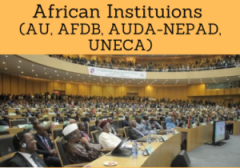
- Economic Commission for Africa
- African Union
- AU Convention on Preventing and Combating Corruption
- AUDA-NEPAD
- African Development Bank
- Africa-India Cooperation

- UN
- WB
- WTO
- IMF

The Republic of Madagascar
- Malagasy Population: 25 million. Growth: 2,7%
- Life expectancy: 64 years
- Malagasy Area: 587,295 km²
- Malagasy Capital: Antananarivo (2.1 million)
- Economic capital of Madagascar: Toamasina
- Largest cities: Antananarivo, Toamasina, and Antsirabe
- Official Languages of Madagascar: Malagasy and French
- English was official language from 2007 to 2010
- Nearest countries to Madagascar: Mozambique, the Comoros, Mauritius, Mayotte, Reunion, the Seychelles, Eswatini, and Tanzania
- Abolition of Slavery in Madagascar: 1896
- Independence of Madagascar from France: 1960
More information about Madagascar (EENI African Business Portal).
Religions in Madagascar:
- African Traditional Religions (52%)
- Christianity(41%)

Madagascar belongs to the East African Economic Area.
The Republic of Madagascar: one of the poorest African Countries.
Malagasy Economy:
- Madagascar is one of the poorest countries in Sub-Saharan Africa
- Malagasy Economic growth: 2.6%
- Malagasy Inflation: 6.9%
- The main sector of the Malagasy economy is agriculture
- 3.6 million tones of rice (the third African producer)
- 1 million tones of cereals (maize, potato)
- Fruits and vegetables
- Litchies: 70% share of the European market. The first world exporter
- 50% of the global vanilla market
- The first world spices and other essential oils exporter
- Malagasy industry (13% of the GDP): soap production, food and tobacco processing, brewing, textiles, and leather
- Ranking in the Doing Business Index (WB): 142
- Malagasy currency: Ariary (not convertible)
Sample - Foreign Trade and Business in Madagascar:
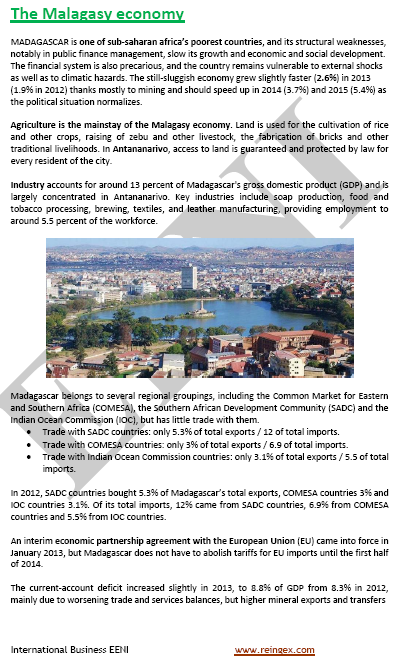

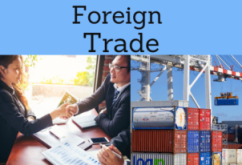
International Trade of Madagascar:
- Malagasy Exports: 1.251 million Dollars (FOB Value)
- Malagasy Imports: 2.619 million Dollars (CIF Value)
- Top Malagasy trading partners: France, Singapore, China, Germany, Canada, India, the U.S., Italy, the UK, and Spain
- Trade with the SADC countries: only 5.3% of the total exports/12% of the total imports
- Trade with the COMESA countries: only 3% of the total exports/6.9% of the total imports
- Trade with the Indian Ocean Commission countries: only 3.1% of the total exports/5.5% of the total imports
- Investment in Madagascar: 386 million Dollars
The mission of the Economic Development Board of Madagascar (Public body) is to encourage the foreign direct investments and create a friendly business climate. The Board has defined six strategic sectors for the Malagasy economic development: tourism, agribusiness, light manufacturing industry, ICT, infrastructure, and mining.
(c) EENI Global Business School (1995-2024)
We do not use cookies
Top of this page


